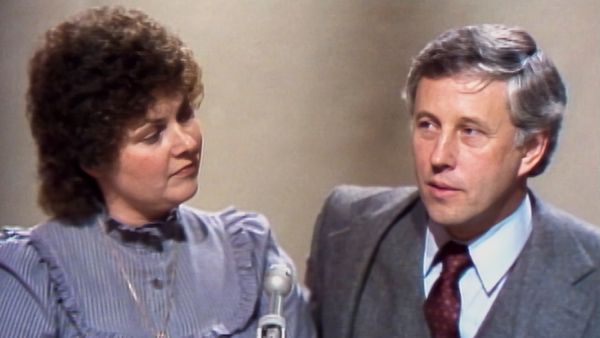 |
| Satan Wants You |
If you are much over 40, the chances are that you will remember the great Satanic Panic of the 1980s. Even if you’re younger, the chances are that you’ve seen references to it in popular culture, including films. What you may not be aware of is the book which started it. Moral panics like this always involve multiple triggers, but Michelle Remembers, by Lawrence Pazder and Michelle Smith, had a massive, worldwide impact, persuading all sorts of otherwise sensible people that, without leaving any physical evidence behind them whatsoever, secret Satanist cults were sacrificing vast numbers of children.
Steve J Adams and Sean Horlor’s new documentary, Satan Wants You, examines the impact of this book and reveals some shocking things about the story behind it. When it screened as part of the Fantasia International Film Festival, I took the opportunity to meet with the two directors and learned that there is even more to this remarkable story, much of it yet to be revealed. We began by talking about their own memories of living through that tumultuous time.
“I grew up in Victoria,” says Sean. “That's the city in British Columbia, in Canada, where Larry and Michelle both were when they wrote Michelle Remembers. I grew up after the book was published, and they actually lived ten minutes down the road from my family, in a giant house overlooking the ocean. They were larger than life figures in my community. They were in the news constantly, on radio, television.
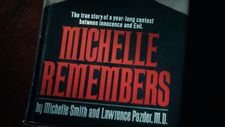 |
| Michelle Remembers |
“A lot of the Satanic Panic was so local, right? Even in the UK, and the cases that were happening in communities in the US and in Canada – I had no idea, until Steve and I started looking into this in 2018, that their book impacted millions and millions and millions of people around the world.”
“I was born in 1980 so I don't really have a big recollection of it,” says Steve. “I was from a very small town, up north, so we didn't really have a whole lot of interaction with the Satanic Panic. In 2018, when we were doing a different series on authors in British Columbia, our researcher provided us with 100 books, and midway down that list was Michelle Remembers. I didn't know what the book was.” He looks at Sean. “But when you saw it, you were like, ‘Okay, this is really interesting.’
“We started to talk about it. At that time, Q-Anon and Pizzagate was happening, and we began to see the connection between the two. And that's when we really wanted to dive into the project.”
“The starting place for a film like this is the book itself,” says Sean. “You have an understanding of what they wrote, and then of course, at the very end of the book, there is an acknowledgements section full of names of people who were involved in the writing and that process. Michelle and Larry’s family members were listed in the acknowledgement section. When we started reaching out to the family, and actually getting some more research from the news coverage from that era, we found that the family had never gone on record to talk about this.
“As soon as you see that, as a documentary filmmaker, you realise there's a whole other side of the story that has never been told, for various reasons. So we really wanted it. The first 30 minutes [of the film], we wanted to be how people experienced Michelle Remembers and the Satanic Panic unfolding in the 1980s. So if you were alive during that period, we wanted it to feel like that – before the turning point and flipping it around and saying ‘No, wait. There's a whole family and the Church of Satan and all these experts who actually have another side of this. So let's see what they have to say.’ And that's the tension in the film that we found.”
He asks me about my own memories of the period, and I tell him that I remember the scariness of being a kid watching adults take drastic actions based on things which were obvious nonsense, whilst feeling powerless to do anything about it. I mention the Orkney Satanic abuse scandal as one example, and he nods.
“Looking into, specifically, the cases in the UK, Michelle Remembers was used in at least one of those trials, and I assume multiple trials, again as concrete evidence that this was happening. I know you can't blame it all on one book, but the fact that it was used in cases in the UK, in the US, all across Canada, in Europe and Australia and New Zealand, and Italy and the list just goes on and on.”
Michelle and Larry’s families must have found it traumatic too, I note. How did they feel about talking about it on the record after all this time?
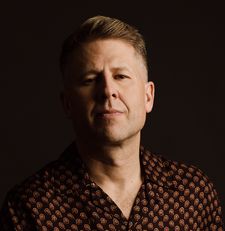 |
| Steve Adams |
“For us, it was like reaching out and just seeing who was open to talking,” says Steve. “There were some people who were immediately wanting to start chatting. There's other people who took a little bit of time, like Larry's daughter. She wanted to talk, but it took some time to actually go through everything. For some of the people it was bringing up a whole lot of trauma, and it was bringing up like a really like purple period of their life. But then other people were ready to go. Michelle’s sister was like, I think out of everybody, she has the largest like social media presence, and so a lot of people would reach out to her. And when we reached out, she realised that we were from Vancouver, and she was ready to talk right away.”
“It did really help that I'm from Victoria, so the same place the families live,” adds Sean.
They have some other fascinating interviewees as well. I mention Kenneth Lanning, from the FBI. How did they get him on board?
“As soon as I found his phone number, I got on the phone with him and he just talked for two hours straight,” says Sean. “The thing with this period of history, whether you're a family member or an expert, I mean, it is so crazy that talking about it with them 40 years later, it's like it happened yesterday. Their recall is so clear. And in Ken's case, he wrote a book called Love, Bombs and Molesters, chronicling his journey as an FBI agent who was in charge of the occult and Satanic crime. He was part of the Mind Hunters group, that elite FBI agency that started actually studying human behaviour. He was one of the early members. And the fact that he spent 15 years of his career investigating Satanic crime – I mean, he's fascinating.” “And that's the thing, right?” says Steve. “For all these people, it did take up like the better part of a decade of their lives. And it was like it just had happened yesterday, it's so ingrained in who they are.”
I tell them that I was intrigued by what their film reveals about the Vatican’s involvement, too, because although I’ve read a great deal about this subject over the years, that aspect had somehow slipped past me.
“We tried to get the bishop in Victoria, Remi De Roo,” says Sean. “He was instrumental. He connected [Larry and Michelle] to the Vatican. He travelled with them. He took them to Rome and actually connected them to senior Catholic officials and eventually got them the audience with not just one pope – we were told – three popes. We tried and tried to get an interview with him. He was in his 90s, and after two months of trying, he actually passed away. It was disappointing because Michelle and Larry had trusted him with the entire transcript of the therapy tapes. He is the one who had all that and so it's out there somewhere. Other investigators who want to take another crack at this, there's some weird stuff that never made it into this.”
It’s a huge story, I agree. How did they decide what to leave out?
“Through the general editing process, where you're trying to focus on what the core story is, for us it was bringing that family aspect into the story,” says Steve. “Being able to jump between what's happening within the family and what's happening in the bigger society and cultural role. It's a tricky thing. There's so much. I think one of the big takeaways, especially from the première, in South by Southwest, was that people just wanted more. They wanted it to be a four part series. They just want to dive into all the fascinating bits that exist within the film.”
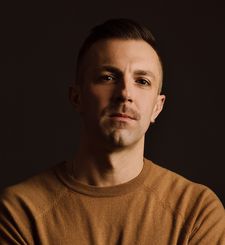 |
| Sean Horler |
Are they tempted to go back and explore it further?
“Absolutely!” they chorus.
“I think we've actually landed on a way to expand this,” says Sean. “Just knowing all the feedback that we got on all these screenings, a series would make make sense. Depending where you are, and your depth of knowledge on the subject, everyone wants a little more of this or a little more of that. The present day, Q-Anon and Pizzagate, those sorts of conspiracies. We will let you know if we get it funded.”
I explain that a lot of what stands out to me about the film is the care they took in evidencing what actually happened with Michelle. It seems to me that there's all the more need to be really forensic about the evidence in a story which is really about lack of evidence and what people will believe when they don't have any.
“But this is the thing,” says Sean. “I mean, the hallmark of a really great conspiracy is that the lack of evidence is evidence. We saw that during the Satanic Panic, you saw it during Pizzagate and Q-Anon. It’s so human, and it's so fascinating.”
I tell him that the Vatican thing fascinated me in part because I had recently been doing some research into Vatican practice on exorcisms for another film I was writing about, so I know that today, if somebody claims to have had a vision of the Virgin Mary, that's one of the red flags that immediately makes them think ‘This kid's making this up.’ It's bizarre that that claim was taken seriously when Michelle made it.
“People loved it, though, right?” says Steve. “Like, I remember there was like a toaster that was making an image of the Virgin Mary on toast and like people would gather to look at it. During that time, everybody just believed that that was true.”
So what surprised the two of them as they collected this material?
“Oh, there's so many different things,” says Sean. “I mean, like you mentioned, it's a 90 minute film, so we had to leave quite a bit of things that we found out of the film. You know, the publisher of Michelle Remembers, his name is Thomas Congdon, he was actually the editor of Jaws. So that book, Jaws, was also a giant bestseller that caused a different kind of giant social panic, a social panic over sharks.
“It's interesting to see all these fingerprints in addition to Michelle and Larry, people that took this book and how it packaged all these cultural fears, and Hollywood movies, and Charles Manson and all that stuff that was happening before 1980, and turned it into this giant bestseller. And there were two ghost writers that worked with Michelle and Larry to write it.”
We discuss the reconstructions of therapy sessions which appear in the film.
“We knew through our research that Larry had filmed the sessions, in addition to recording the audio,” says Sean. “We searched and searched and searched because we knew that somebody must have these films. But where we ended up is that there was this still from the film footage that he shot in People Magazine that was published in 1980s. So you can actually see Michelle on the couch, laying on the pillows, and get a feel for what his office actually looked like and what was happening and what she was wearing and the look on her face when she was in a trance – that was how it was described.
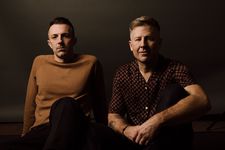 |
| Sean Horler and Steve Adams |
“We wanted that video footage that he shot so bad, and could not get it. So our creative approach to that was ‘Hey, let's actually bring this still, which was real life, and build on it.’ This was such an important part of the story that people should see the therapy sessions. You can't relate that to present day therapy, what was happening there.”
“Through the book that you were learning that they were getting closer and closer,” says Steve. “It started off with just regular therapy, and maybe you slowly watched them go into cuddle sessions, or it was happening at night, and just being able to actually show that I think was able to make people understand that it was so much more than just a regular therapy session, and that there was something underneath what was actually happening.”
They did a lot of touring together and appeared on a huge number of talk shows, but Steve says that it was actually difficult to get hold of clips from those.
”At that time, the transition was happening from Betamax to video cassette and to make those types of changes was really expensive, so a lot of the times they just they weren't digitised or they were thrown out or they just were recorded over. So it was really tricky for us to find archive of them actually doing the interview. When we came across To Tell The Truth, that was a really big find for us. We were really excited that they still had it, and it really showed what they were doing and how they were going about their press.”
They’re both excited about the success they’ve had on the festival circuit.
“ I didn't expect the film to catch on, on the genre circuit, as much as it has,” says Steve. “Audiences at all the genre festivals have really, really loved it, and it's been really fun to be incorporated into a lot of these programmes. Documentaries usually aren't a popular sell, and it's usually one of the top films that people want to see. That's really, really great for us. I didn't expect it to happen and it's really cool to see.”
“As newer, indie filmmakers to we didn't have much support,” says Sean. “We submitted to South By through the slush pile with thousands of other films. I wrote the programmers and said, ‘Hey, listen, please watch. This is our story.’ It wasn't a sales agent or distributor got us into South By, it was us sweating to make it happen. And to see this response to our film, I mean, it's just...” He trails off, visibly still overwhelmed by it all. “And then all this love that we've got from film festivals and people on Rotten Tomatoes and Letterboxed, it’s like ‘Yes! We did it.’”
“I think a lot of people watch it and just can't believe that this happened,” says Steve. “Especially younger people. They had no idea that this happened. And to see it all laid out and to see all the talk show hosts and to see the news and to see everybody involved saying just like the wildest shit - and that was what happened. That's what happened for a decade.”
Satan Wants You arrives in Canadian cinemas on Friday, 11 August.





















